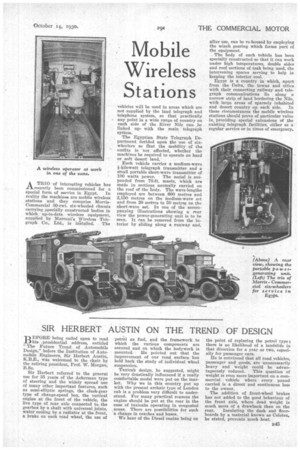SIR HERBERT AUSTIN ON THE TREND OF DESIGN
Page 71

If you've noticed an error in this article please click here to report it so we can fix it.
• EFORE*being called upon to read Ma/ his_ ;presidential address, entitled "The Future Trend of Automobile Design," before the Institution of Automobile Engineers, Sir Herbert Austin, K.11.E., was welcomed to the chair by the retiring president, Prof. W. Morgan, B.Sc.
Sir Herbert referred to the general use for 35 years of the Ackerman type of steering and the widely spread use of many other important features, such as semi-elliptic springs, the clash-gear type of change-speed box, the vertical engine at the front of the vehicle, the live type of rear axle connected to. the gearbox by a shaft with universal joints, water cooling by a radiator at the front, a brake on each road wheel, the use of petrol as fuel, and the framework to which the various components are secured and on which the bodywork is mounted. He pointed out that the improvement of our road surface -has held back the study of individual wheel suspension.
Taxicab design, he suggested, might be very drastically influenced if a really comfortable model were put on the market. Why we in this country put up with the present archaic type of London cab is a problem very difficult to understand. For many practical reasons the engine should be put at the rear in the case of taxicabs operating in congested areas. There are possibilities for such a change in coaches and buses.
We hear of the Diesel engine being on
the point of replacing the petrol type: there is no likelihood of a landslide in that direction for a year or two, especially for passenger cars.
He is convinced that all road vehicles, passenger and goods, are unnecessarily heavy and weight could be advan tageously reduced. This question of weight is even more important on a commercial vehicle where every pound carried is a direct and continuous loss to the owner.
The addition of front-wheel brakes has not added to the good behaviour of the front axle, where dead weight is much more of a drawback than on the rear. Insulating the dash and floorboards by a material known as Celotex, he stated, prevents much heat.




















































































































